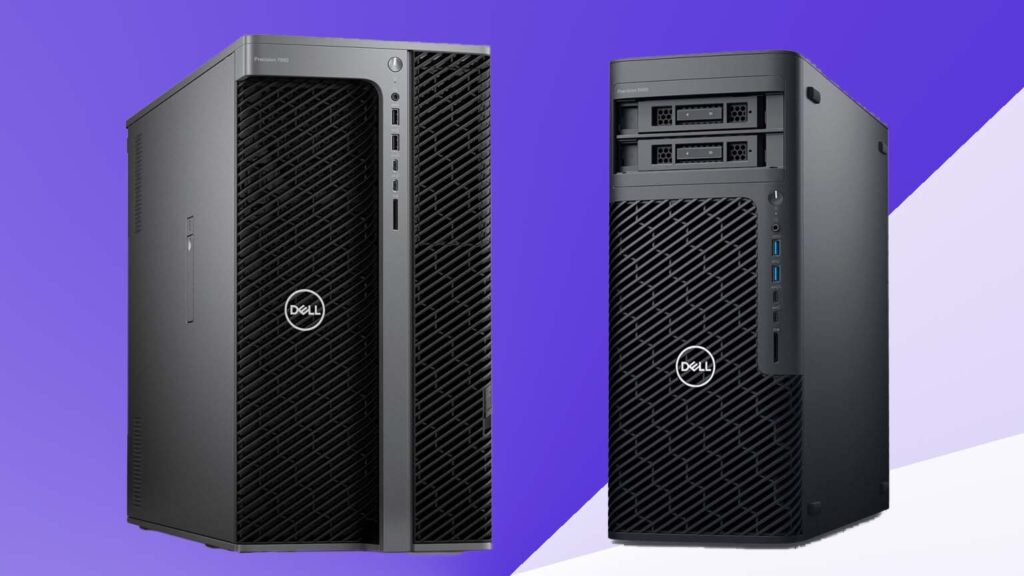Company’s ‘Sapphire Rapids’ desktop workstations focus exclusively on single-socket Intel Xeon W-2400 and W-3400 workstation processors
Dell has launched the Dell Precision 5860 Tower and Precision 7960 Tower, a duo of ‘Sapphire Rapids’ desktop workstations that will replace the company’s ageing ‘Cascade Lake’ Dell Precision 5820 and Precision 7920.
Both workstations are single socket. The Precision 5860 Tower comes with a choice of Intel Xeon W-2400 processors up to the 24-core Intel Xeon w7-2495X, and supports up to two double height GPUs, including the Nvidia RTX A6000 and AMD Radeon Pro W6800.
The Precision 7960 Tower offers Intel Xeon W-3400 processors up to the 56-core Intel Xeon w9-3495X and supports up to four double height GPUs. Dell does not mention the new Nvidia RTX 6000 Ada Lovelace generation for this release. However, we expect support for this super high-end card will follow soon.
Unlike Lenovo and HP, Dell has not launched a dual socket ‘Sapphire Rapids’ desktop workstation with 4th Gen Intel Xeon Scalable processors. However, it is the only one of the major three to release a dedicated rack workstation to support remote graphics deployments. The Precision 7960 Rack is a 2U machine which can support up to two 56-core Intel Xeon Platinum 8480+ processors and up to two double height GPUs.
Beyond CPU and GPU, the Precision 5860 and Precision 7960 differentiate themselves largely by memory capacity and expandability.
The Precision 5860 can be configured with up to 512 GB of DDR5 memory (support for 2 TB will come later with availability of 128 GB and 256 GB DIMMs). It has two lockable front drive bays, support for M.2 SSDs and 2.5-inch / 3.5-inch HDDs, and up to 56 TB of total storage.

The mid-size tower is slightly smaller than the Precision 5820 it replaces and comes with a back carry handle. It looks to share the same chassis as the AMD Ryzen Threadripper Pro-based Precision 7865 Tower Workstation that launched last year.
The Precision 7960 can be configured with up to 1 TB DDR5 at launch and up to 4 TB post launch (with 128 GB / 256GB DIMMs).
It has six lockable front drive bays and up to 152 TB of total storage. It is slightly smaller than the Precision 7920 it replaces, although this was a dual socket machine.
Both workstations offer dual network ports (1G + 10G) and optional Wireless LAN and will be avaialble from 18 April 2023.
What DEVELOP3D thinks
Dell has taken a different approach to HP (HP Z6 / Z8 / Z8 Fury) and Lenovo (ThinkStation P5, P7, PX) for its ‘Sapphire Rapids’ desktop workstations. It has focused exclusively on Intel’s single socket Xeon W-2400 and W-3400 workstation processors, ignoring the server-focused 4th Gen Intel Xeon Scalable altogether. However, with its two machines, Dell should have most bases covered in AEC, especially with the Precision 7960 supporting 4 GPUs on top of its 56-cores and 4 TB of memory.
In addition, one must not forget the Precision 7865 Tower Workstation, which carries the 64-core AMD Ryzen Threadripper Pro processor. If Dell continues this relationship with AMD into the next generation, and especially if there is substance to rumours of a 96-core Threadripper Pro, then Dell should still be well covered in the most demanding of multi-threaded workflows.
Of course, there’s also virtual workstations to think about, and while HP and Lenovo are choosing to build ‘server grade’ features into their desktop units, Dell covers the datacentre with its dedicated dual socket Precision 7960 Rack.
While on paper this 2U machine offers much greater user density compared to HP and Lenovo’s 4U/ 5U offerings, it can only support up to two GPUs, so those with more demanding GPU-centric workflows may lose out or have to use two machines instead of one, which will likely add to costs.
Meanwhile, Dell has launched new 13th Gen Intel Core Precision laptops






